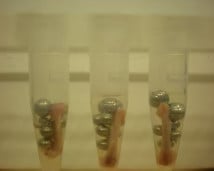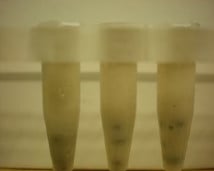Reference Manual with helpful suggestions and pictures
4°C Cooling™ in the Bullet Blender®:
What is 4°C Cooling?
The Gold model Bullet Blenders have a smart, integrated 4°C cooling system which monitors the motor parameters and the air temperature, so it accurately controls the cooling to keep your samples at about 4C. 4°C cooling uses a compartment filled with dry ice to keep samples at 4°C within a couple of degrees. When the instrument is in operation, cold air from the compartment is drawn into the instrument, cooling the samples. Some users prefer to pre-cool their Bullet Blenders before use. To pre-cool, fill the compartment with dry ice, remove any tubes from the instrument and select Cool Down from the main menu of your Bullet Blender Gold.
Which models have 4°C Cooling?
The 4°C cooling feature comes on Gold models of the Bullet Blender®. The BB24AU which homogenizes samples in 1.5 mL microcentrifuge tubes, the BB5EAU which homogenizes samples in 5 mL tubes and BB50AU which homogenizes samples in 50 mL tubes.
How does 4°C cooling work so well?
The dry ice cooling system in the Bullet Blender Gold models is fully integrated with the instrument. (Most or all other homogenizers with cooling, have separate cooling modules or use cooling packs.) The Bullet Blender Gold models use temperature sensors and also monitor the homogenization conditions, so they can compensate for these factors and provide the precise amount of cooling to keep samples at or very near 4C, within a degree or two. Also, the operating principal of the Bullet Blender is different than other bead mill homogenizers, so samples are not subjected to as much heat, and therefore, do not need to be cooled as much.
How much dry ice do I need to use 4°C Cooling?
It takes at least 2 lbs of dry ice for the instrument to achieve maximum cooling. We recommend filling the chamber with 3 lbs of dry ice- depending on how heavily the instrument is used, this should keep samples at 4°C for an entire day of homogenization.
Can I use regular ice with 4°C Cooling?
You can use some regular ice from a -80 Freezer, however, it will not be as effective or last as long as dry ice. Secondly, the melt water will block the flow of air for cooling the samples. The melt water, if spilled, could damage the Bullet Blender and void any warranty. Drawing moist air into the unit may also cause damage to the electronics over time.
Why is my Gold instrument not cooling, or (on older Gold models) why is the 4°C light not lighting up on my unit?
Frost from condensation may be blocking the air flow. Remove the inner dry ice compartment and replace the ice. If your dry ice has been stored for a long time, it may also contain some water ice from condensed humidity in the air and will be less effective in cooling the unit. It is essentially to replenish the dry ice and using the Wholly Scooper, filter out the “snow” for proper air flow. See video below.
What will happen if I operate my Bullet Blender Gold unit with no dry ice?
When there is no dry ice in the compartment, you should operate the instrument with the lid of the dry ice compartment open so that the fan can draw in ambient air around your samples. Also known as air cooling.
Air Cooling™:
What is Air Cooling?
All models have Air Cooling. These models exchange air with their surroundings; they do not have refrigeration units. Air Cooling draws cool air into the instrument if you are using the Bullet Blender in a cold room or a refrigerated cabinet keeping samples below room temperature. Air Cooling is also useful if you’re running several sample cycles in a row or if your samples are extra sensitive to heating up. Normally, the samples in the Bullet Blender only heat up a few degrees and stay quite cool. However, if you’re running a second batch of samples soon afterward, they will heat up a little more because the Bullet Blender is starting out slightly warmer. The Air Cooling keeps the Bullet Blender cooler so that the first batch of samples heat up a little less and subsequent batches are kept just about as cool as the first batch.
Which models have Air Cooling?
The Air Cooling feature comes on all models of the Bullet Blender. Gold models can be run without dry ice to achieve Air Cooling mode. To do this leave the dry ice compartment lid open to enable air exchange.
General FAQs:
How is the Bullet Blender different from other high-throughput homogenizers on the market?
The Bullet Blender is similar to other bead mill style homogenizers in that it processes each sample in its own tube using homogenization beads. Therefore, there is no chance of cross-contamination and there are no parts that need cleaning after each sample.
A unique feature of the Bullet Blender is the way it agitates the sample tubes. Other bead-mill homogenizers vigorously shake the sample tubes, which requires a great deal of energy and heats up the samples. The large motors required tend to make these homogenizers large and expensive; many are over twice the cost of the Bullet Blender.
The Bullet Blender, on the other hand, uses a patented striking technology. Strikers impact the sample tubes. These bursts of energy force the sample tubes to oscillate vigorously in 3 dimensions, at a range of frequencies, up to over 100 Hz (equivalent to six thousand cycles per minute). We find that a range of frequencies is more effective than a single frequency. This method avoids the need to clamp tubes into a holder, so loading the sample tubes in the Bullet Blender is much easier and quicker. The Bullet Blender is smaller, lighter, and less expensive than competitors’ equipment while working just as well.
Also unique to the Bullet Blender, the sample tubes rapidly oscillate in a stream of rapidly flowing air, providing convective cooling and sample heating is minimal. In other homogenizers, samples are clamped into a holder, preventing air exchange. The Gold models keep the samples at 4°C using sensor feedback and knowledge of the motor conditions. The Bullet Blender can also be used in a cold room.
What types of tubes can be used?
Microcentrifuge models: The Bullet Blender Storm (discontinued), Storm Pro, Lite, and Gold models work with our RINO® tubes, or 1.5 mL Eppendorf Safe-Lock® tubes (not the LoBind version though). The Bullet Blender Lite requires the purchase of an additional adapter kit to work with the RINO tubes. The Bullet Blender Storm Pro generates greater impact energy at speeds 10 and 12, compared with previous Bullet Blender Storm models, resulting in improved homogenization performance. If using Eppendorf Safe-Lock® snap cap tubes at these speeds, limit quantity to 12 tubes and leave an open space between tubes to prevent caps from coming loose (limitation does not apply to RINO tubes). The standard Bullet Blender (discontinued) and Bullet Blender Blue (discontinued) work with 1.5 mL or 2.0 mL Eppendorf Safe-Lock® tubes. When using 2 mL tubes in the the Bullet Blender or the Bullet Blender Blue we recommend using a minimum of 2 tubes per homogenization cycle. The discontinued screw cap models (BBX24W and BBX24BW) use Axygen® 1.5 mL screw-cap tubes.
5 mL tube models: The Bullet Blender Storm 5 works with 5 mL Axygen brand screw top transport tubes (both are discontinued). The Bullet Blender 5E Pro (and the discontinued Bullet Blender 5E) work with Eppendorf 5 mL snap-cap conical tubes. As these snap cap tubes are different in size than the Axygen screw cap tubes, the 5 mL models can handle one type of tube or the other, but not both in the same instrument.
50 mL tube models: The Bullet Blender 50DX and 50AU (DX and Gold models) work with 50 mL skirted (self-standing) polypropylene tubes, such as TPP® brand or Corning® brand. Generally high quality tubes work better (rather than bargain brand tubes which are not as strong).
How do you set the Bullet Blender to mix, disrupt, or homogenize different types of samples?
You can adjust the speed and the duration of a cycle. Adjusting the speed affects the momentum applied by the strikers to the sample tubes, and thus the force applied to the sample by the beads. The “speed” setting is a relative measure of homogenization power. A direct measure of speed (such as RPM or mps) would be misleading because the sample tubes oscillate at a range of frequencies. Adjusting the duration affects the total number of impacts. Homogenizing tough tissue requires longer durations at full speed, while mixing or cell dissociation requires lower speeds and duration.
How easy is it to operate the Bullet Blender?
Simply place up to 24 sample tubes in the holders, set the desired duration and speed, and push start. All the samples will be processed simultaneously, without any chance of cross contamination.
How much sample can be homogenized in each microcentrifuge tube?
General tip: Tubes should be filled no more than 75% full (50% for 50 mL tubes). The air volume inside the tube is critical to allow the sample to be ground up inside the tube, so if the tube is overfilled the efficiency of the homogenization is reduced.
For microcentrifuge model Bullet Blenders, we recommend using 10-300 µL of sample. Less than 10 µL will work, but it requires careful attention to the amount of beads and volume of homogenization buffer. The 5 mL tubes can hold up to about 1 mL of sample. The 50 mL tubes can hold up to about 3.5 mL of sample. Note that for most wet organ tissue an easy approximation of volume is 1 mL≈1 g.
Do sample tubes need to be placed symmetrically?
No. There are no restrictions as to which holes to place your sample tubes in, however you may get more efficient results if you space them evenly apart.
How do you retrieve the sample from the tubes?
After the Bullet Blender stops, simply remove the tubes and draw off the liquid with a pipet. If a clear lysate is desired, the sample may be centrifuged to clarify the lysate prior to use in your applications. Tubes may be centrifuged with the beads in them for ease of handling.
Which beads should I use?
The protocols page contains suggested beads, speeds, and durations for processing many types of tissues and cells. The two basic rules for bead selection: (1) use denser beads for tougher samples, and (2) use beads of a comparable size to the size of your samples to maximize the effectiveness of collisions between beads and samples. For example, if you wanted to lyse mammalian cells with a soft membrane, use small beads. If you want to homogenize larger pieces of tough tissue, use large steel beads. “”UFO” beads are excellent for homogenizing fibrous or resilient samples. You can also contact our technical support staff at [email protected] if you have any questions.
I am trying to process tough samples in the Bullet Blender and the homogenization is incomplete. How can I improve my results?
- Examine the shape of your samples – long thin samples will homogenize faster than cube-shaped or round samples.
- Try cutting your samples into smaller pieces.
- Ensure your tubes are not overloaded.
- If you are running many samples at once in the standard or Blue models of the Bullet Blender (BBX24 or BBX24B), try running fewer tubes at a time. If a sample is extremely tough (e.g. mouse femur) you may only be able to achieve complete homogenization with 2-4 tubes at a time.
- If you are using the BB50DX or BB50AU, make sure that all of the sleeves are removed except for the sleeves containing tubes.
I previously owned another bead mill homogenizer. Can I use the same protocols that we developed for the other homogenizer with the Bullet Blender?
Yes, if your previous homogenizer was a Bullet Blender. Each speed setting provides relative homogenization performance across all models.
No, if your previous homogenizer was not a Bullet Blender. The mechanism of action is different from all other homogenizers on the market. Our patented striking technology makes the Bullet Blender both highly efficient and effective. If you use another product’s protocol with the Bullet Blender, you are very likely to experience different results. Please use one of our established protocols, or empirically determine a protocol that works best for your samples. We also offer free protocol development services.
Is it possible to homogenize tissue that has been frozen in liquid nitrogen?
It is possible to homogenize tissue that was frozen in liquid nitrogen. Immerse the frozen tissue in cold buffer and allow it to thaw, then treat it as you would any other sample. If the tissue was dried before it was frozen, you can pulverize the tissue by homogenizing with beads only (no buffer), then adding the cold buffer and running again to complete the homogenization. You cannot homogenize “wet” tissue while it is still frozen, as it will effectively be a block of ice and homogenization efficiency will be very poor.
After homogenizing my samples in RINO tubes, can I centrifuge the tubes?
During homogenization, the tubes are physically hit by the beaters in the Bullet Blender and the material integrity of the tubes is compromised. We therefore, recommend to centrifuge the tubes not more than 6000xg to prevent tube cracks and sample leakage.
Contact us if you have any more questions.



